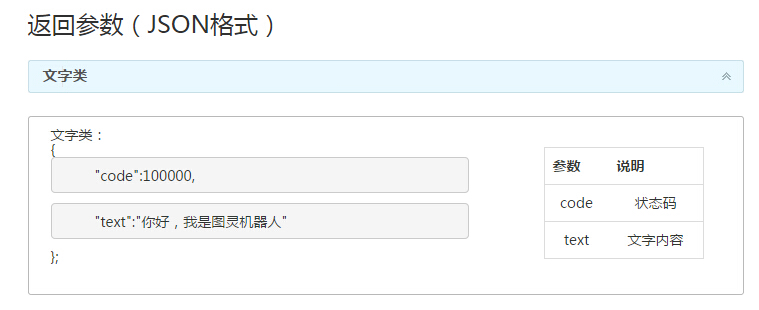这个聊天机器人有点像前段时间很火的一个安卓应用——小黄鸡
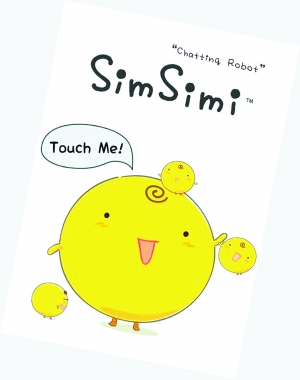
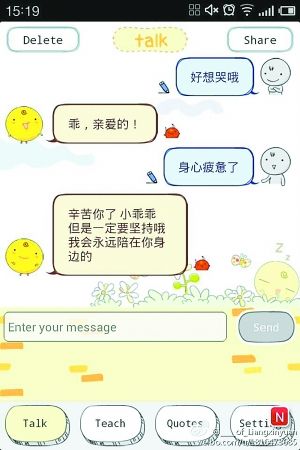
应用的实现其实很简单,网上有许多关于智能机器人聊天的接口,我们只需要去调用对应的接口,遵守它的API开发规范,就可以获取到我们想要的信息
这里我使用的接口是——图灵机器人(http://www.tuling123.com/openapi/)
这个接口给我们返回的是Json字符串,我们只需要对它进行Json字符串解析,就可以实现这个应用。
开发步骤:
首先我们需要到这个图灵机器人的官网去注册一个账号,他会给我们一个唯一Key,通过这个Key和对应的API开发规范,我们就可以进行开发了。
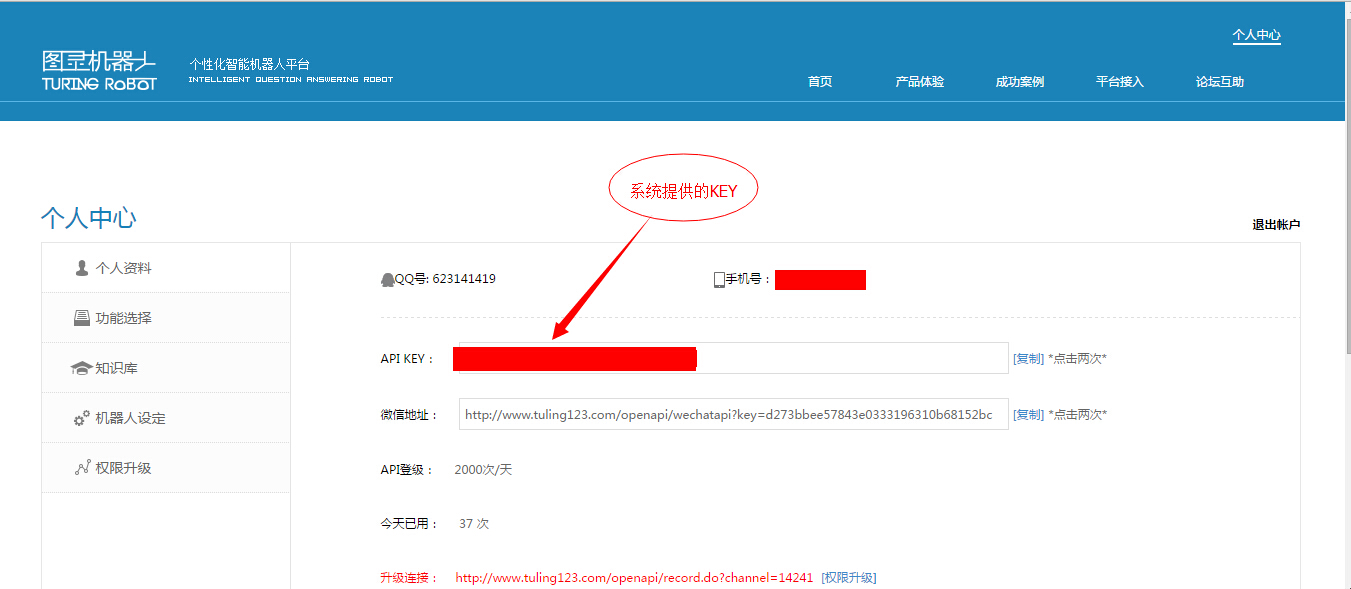
然后在这个(http://www.tuling123.com/openapi/cloud/access_api.jsp)网址里可以找到相关的开发介绍
比如:请求方式,参数,返回参数,包括开发范例,一些返回的编码等信息
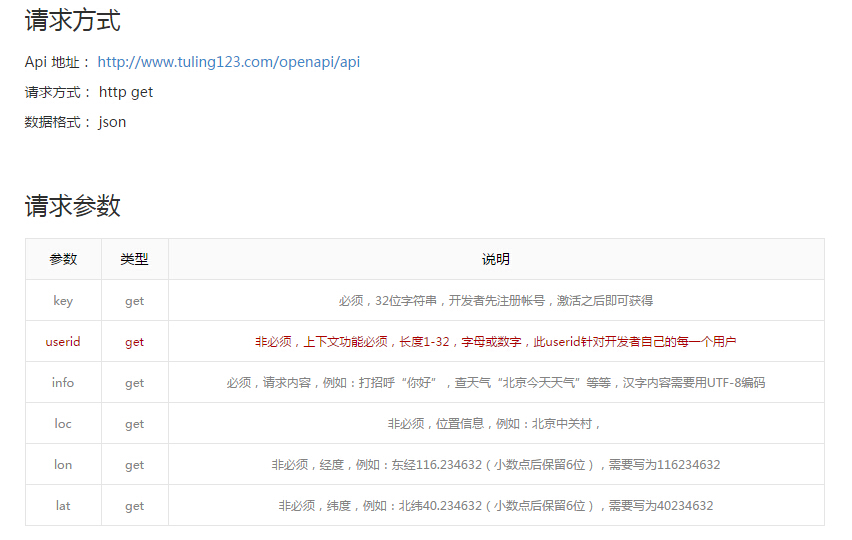
这里是官方提供的一个调用小案例(JAVA),这里我也顺带贴一下
1 /** 调用图灵机器人平台接口 2 * 需要导入的包:commons-logging-1.0.4.jar、 httpclient-4.3.1.jar、httpcore-4.3.jar 3 */ 4 public static void main(String[] args) throws IOException { 5 6 String INFO = URLEncoder.encode("北京今日天气", "utf-8"); 7 String requesturl = "http://www.tuling123.com/openapi/api?key= 注册激活返回的Apikey&info="+INFO; 8 HttpGet request = new HttpGet(requesturl); 9 HttpResponse response = HttpClients.createDefault().execute(request); 10 11 //200即正确的返回码 12 if(response.getStatusLine().getStatusCode()==200){ 13 String result = EntityUtils.toString(response.getEntity()); 14 System.out.println("返回结果:"+result); 15 } 16 }
好了,接下来开始实战吧,这个应用我打算写成两篇文章
第一篇讲下关于如何调用接口,从网上获取数据,包括解析Json字符串
第二篇会把这些获取的数据嵌入到安卓应用
首先,先写一个工具类,这个工具类是用来获取用户输入的信息并返回服务器提供的数据的
这里面用到了一个第三方提供的JAR包,Gson它是谷歌提供给我们用来使Json数据序列化和反序列化的
关于Gson的使用我之前写过一篇笔记,不熟悉的朋友可以看看:Gson简要使用笔记(http://www.cnblogs.com/lichenwei/p/3987429.html)
代码如下:具体看注释
1 package com.example.utils; 2 3 import java.io.ByteArrayOutputStream; 4 import java.io.IOException; 5 import java.io.InputStream; 6 import java.io.UnsupportedEncodingException; 7 import java.net.HttpURLConnection; 8 import java.net.MalformedURLException; 9 import java.net.URLEncoder; 10 import java.util.Date; 11 12 import android.util.Log; 13 14 import com.example.pojo.Message; 15 import com.example.pojo.Message.Type; 16 import com.example.pojo.Result; 17 import com.google.gson.Gson; 18 19 /** 20 * 21 * 获取信息帮助类 传入用户输入的字符,给出相对应的信息 22 * 23 */ 24 public class GetDataUtils { 25 26 private static final String API_KEY = "这里填写官方提供的KEY";// 申请的API_KEY值 27 private static final String URL = "http://www.tuling123.com/openapi/api";// 接口请求地址 28 29 public String getChat(String msg) {//这个方法是获取服务端返回回来的Json数据,msg为用户输入的信息 30 String result = "";// 存放服务器返回信息的变量 31 InputStream inputStream = null; 32 ByteArrayOutputStream outputStream = null; 33 try { 34 // 进行资源请求 35 java.net.URL url = new java.net.URL(getMsgUrl(msg)); 36 HttpURLConnection httpURLConnection = (HttpURLConnection) url 37 .openConnection();// 打开资源连接 38 39 // HttpURLConnection参数设定 40 httpURLConnection.setReadTimeout(5 * 1000); 41 httpURLConnection.setConnectTimeout(5 * 1000); 42 httpURLConnection.setRequestMethod("GET"); 43 44 inputStream = httpURLConnection.getInputStream();// 获取一个输入流接收服务端返回的信息 45 int len = -1; 46 byte[] bs = new byte[124];// 用来接收输入流的字节数组 47 outputStream = new ByteArrayOutputStream();// 用一个输出流来输出刚获取的输入流所得到的信息 48 49 while ((len = inputStream.read(bs)) != -1) {// 从输入流中读取一定数量的字节,并将其存储在缓冲区数组 50 // bs 中 51 outputStream.write(bs, 0, len);// 往输入流写入 52 } 53 outputStream.flush();// 清除缓冲区 54 result = new String(outputStream.toByteArray());// 转换成字符串 55 } catch (MalformedURLException e) { 56 e.printStackTrace(); 57 } catch (IOException e) { 58 e.printStackTrace(); 59 } finally { 60 // 关闭相关资源 61 if (inputStream != null) { 62 try { 63 inputStream.close(); 64 } catch (IOException e) { 65 e.printStackTrace(); 66 } 67 } 68 if (outputStream != null) { 69 try { 70 outputStream.close(); 71 } catch (IOException e) { 72 e.printStackTrace(); 73 } 74 } 75 } 76 Log.i("tuzi", "result:" + result);//打印测试日志 77 return result; 78 } 79 80 private String getMsgUrl(String msg) throws UnsupportedEncodingException { 81 String path = ""; 82 String info = URLEncoder.encode(msg, "UTF-8");// 转换url编码 83 path = URL + "?key=" + API_KEY + "&info=" + msg; 84 return path; 85 } 86 87 public Message getInfo(String msg){ 88 Message message=new Message(); 89 Gson gson=new Gson(); 90 try { 91 Result result=gson.fromJson(getChat(msg), Result.class);//获取到服务器返回的json并转换为Result对象,Result对象可能不存在,会出现异常 92 message.setMsg(result.getText());//message可能为空,需要捕获异常 93 } catch (Exception e) { 94 //可能服务器没有返回正常数据,也就存在着空白内容,需要捕获异常 95 message.setMsg("服务器繁忙,请稍后再试"); 96 } 97 message.setTime(new Date()); 98 message.setType(Type.INCOME); 99 return message; 100 } 101 102 }
下面这2个是实体类,根据官网提供的示例,返回的Json字符串里包含:code状态码,text文本内容
1 package com.example.pojo; 2 /** 3 * 4 * 用来映射返回Json字符串 5 * 6 */ 7 public class Result { 8 9 private String code; 10 private String text; 11 12 public String getCode() { 13 return code; 14 } 15 public void setCode(String code) { 16 this.code = code; 17 } 18 public String getText() { 19 return text; 20 } 21 public void setText(String text) { 22 this.text = text; 23 } 24 25 26 27 }
1 package com.example.pojo; 2 3 import java.util.Date; 4 5 public class Message { 6 7 8 private String name; 9 private String msg; 10 private Date time; 11 private Type type; 12 13 public enum Type{//类型枚举,发送,接收 14 INCOME,OUTCOME 15 } 16 public String getName() { 17 return name; 18 } 19 20 public void setName(String name) { 21 this.name = name; 22 } 23 24 public String getMsg() { 25 return msg; 26 } 27 28 public void setMsg(String msg) { 29 this.msg = msg; 30 } 31 32 public Date getTime() { 33 return time; 34 } 35 36 public void setTime(Date time) { 37 this.time = time; 38 } 39 40 public Type getType() { 41 return type; 42 } 43 44 public void setType(Type type) { 45 this.type = type; 46 } 47 48 49 50 }
编写个测试类
1 package com.example.test; 2 3 import android.test.AndroidTestCase; 4 import android.util.Log; 5 6 import com.example.pojo.Message; 7 import com.example.utils.GetDataUtils; 8 9 public class GetDataUtilsTest extends AndroidTestCase { 10 11 public void test(){ 12 GetDataUtils dataUtils=new GetDataUtils(); 13 Message message=dataUtils.getInfo("你好"); 14 Message message1=dataUtils.getInfo("你是谁"); 15 Message message2=dataUtils.getInfo("你知道JAVA是什么吗"); 16 Message message3=dataUtils.getInfo("下雨了,天好冷"); 17 Log.i("兔子",message.getMsg()); 18 Log.i("兔子",message1.getMsg()); 19 Log.i("兔子",message2.getMsg()); 20 Log.i("兔子",message3.getMsg()); 21 22 } 23 24 }
在JAVA WEB里编写测试单元用到的是Junit,需要导入jar包,在安卓开发里也有类似这样的步骤
首先我们要在AndroidManifest.xml里的application标签里添加
<uses-library android:name="android.test.runner" />
然后在application外添加
<instrumentation android:name="android.test.InstrumentationTestRunner" android:label="ceshi" android:targetPackage="com.example.androidchat" > </instrumentation>
由于需要联网别忘了给应用赋予网络权限
<uses-permission android:name="android.permission.INTERNET" />
这里是完整文件代码:
1 <?xml version="1.0" encoding="utf-8"?> 2 <manifest xmlns:android="http://schemas.android.com/apk/res/android" 3 package="com.example.androidchat" 4 android:versionCode="1" 5 android:versionName="1.0" > 6 7 <uses-sdk 8 android:minSdkVersion="8" 9 android:targetSdkVersion="21" /> 10 11 <uses-permission android:name="android.permission.INTERNET" /> 12 13 <application 14 android:allowBackup="true" 15 android:icon="@drawable/ic_launcher" 16 android:label="@string/app_name" 17 android:theme="@style/AppTheme" > 18 <uses-library android:name="android.test.runner" /> 19 20 <activity 21 android:name=".MainActivity" 22 android:label="@string/app_name" > 23 <intent-filter> 24 <action android:name="android.intent.action.MAIN" /> 25 26 <category android:name="android.intent.category.LAUNCHER" /> 27 </intent-filter> 28 </activity> 29 </application> 30 31 <instrumentation 32 android:name="android.test.InstrumentationTestRunner" 33 android:label="ceshi" 34 android:targetPackage="com.example.androidchat" > 35 </instrumentation> 36 37 </manifest>
看下我们的测试代码效果图:
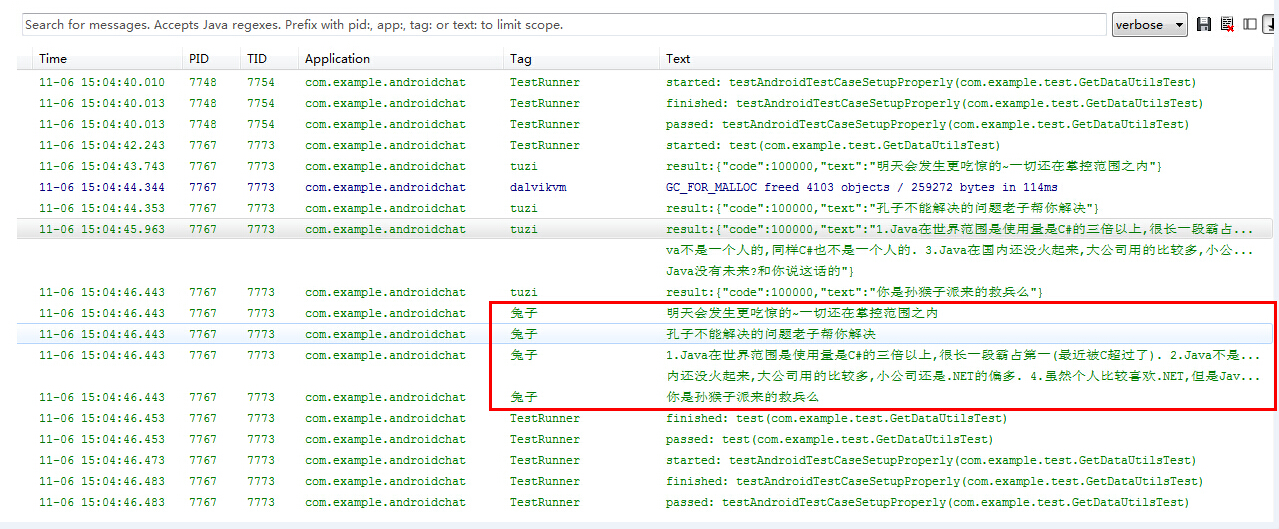
好了,此时我们已经可以获取到服务端的数据,并且接收到客户端并做处理,下篇文章《安卓智能聊天机器人开发(二)》写下关于如何嵌入到安卓应用里。
